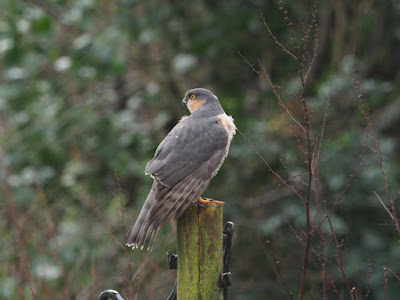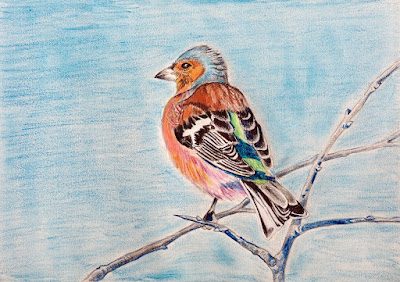This month’s highlights include the long-staying Pacific Diver, plus Red-necked Grebe, Purple Sandpiper, Glaucous and Mediterranean Gull, Little Auk and Hawfinch.
Apart from the regular pair of Mute Swans at Agnew Park the only record of this species on Loch Ryan was on the 19th, when a singleton was observed at Sand Mills. Whooper Swans have been seen regularly for a while now in the fields north of Leswalt - a traditional stop-off point for a few birds, at least, before heading back to Iceland to breed. Loch Connell hosted 27 such birds on, funnily enough, the 27th. This site also held many Pink-footed Geese (2000 on the 19th), fattening up on the grass in the surrounding fields before their northward journey over the Atlantic, also to the land of the ‘Green Lights’. Smaller numbers of Greylags (162 on the 13th) have been doing the same thing. Pale-bellied Brent Geese were seen daily grazing the fields adjacent to the Wig track. Their numbers fluctuated somewhat but flocks comprising in excess of 200 birds were recorded on the 5th, 8th, 11th, 14th, 17th and 21st.
 |
| Whooper Swans ride the waves on Loch Connell |
A pleasant surprise at Loch Connell on the 27th was a handsome drake Gadwall and his duck. The highest count of Teal came from the estate marsh on the 17th, when 140 were observed. The whistles of the males initially drew my attention to them, followed by the sighting of just a few birds; however, the brightness of the day encouraged me to linger for several minutes and the reward justified the wait when more birds emerged from the cover of rushes and they all congregated on the open water of one of the pools. Wigeon were something of a hit-and-miss species about the Wig. Most days there were none, or only a few, to be seen; occasionally there were several score, and more, with a peak of 163 on the 25th.
Over 100 Common Scoters on Loch Ryan were logged on three dates during the month, the highest count being 158 on the 13th. By comparison there was just one record of Velvet Scoters: two males on the 17th. The numbers of Eiders peaked at 240 on the 19th, whilst on the 1st a tight assembly of 148 birds gathered on the Scar. Presumably, the sea loch held many more Goldeneye than were actually recorded; small parties of them were the norm’, with a peak of 34 on the 17th. Long-tailed Ducks are eagerly sought after by many visiting birders. I have been fortunate to see them daily from my house as they go about their business in Wig Bay. A flock of 12 drakes, in striking winter dress, was a delight to behold on the 2nd.
The distribution pattern of Red-breasted Mergansers appeared to mirror that of the Goldeneyes; a monthly maxima of 58 on the 8th was, I suspect, just a fraction of the actual population present. My only record of a Scaup curiously came from the freshwater site of Loch Connell, on the 27th.
Divers on Loch Ryan are always of interest to me and, once again, this month did not disappoint. Red-throated Divers were both numerous and frequent visitors: 89 was the highest count, on the 2nd, and included a raft of 23 birds. Although the majority of them were still in winter plumage there were a few ’transitional’ birds and a handful in full summer attire. Black-throated Divers were noted on six occasions: singletons on the 2nd, 7th, 8th, 19th and 21st and two birds on the 3rd. Individual Great Northern Divers were logged on the 2nd, 8th, 10th, 13th, 22nd, 23rd and 25th, with three occurring on the 19th. The month, however, will be fondly remembered for the almost daily (only four days not seen) views of the long-staying Pacific Diver. The times when it was close inshore I had not my camera with me, and the occasions when I was armed and ready, so to speak, it remained uncannily out of range for a decent image to be captured.
A high of 35 Slavonian Grebes was noted in Wig Bay on the 2nd and 3rd. Quite a few of them showed indications of changing from winter plumage in to summer; some were very pronounced in this respect. Such ’transitional’ dress can make them appear like an entirely different species, so careful scrutiny of some birds was especially prudent. On the 12th and 15th such observation paid dividends with a Red-necked Grebe being espied.
 |
| A Heron practises its stalking |
Lapwings, you may recall, are not a common species on my local patch. A lone bird on the ‘Pool Field’, on the 5th, was the only record. Grey Plovers at the Scar reached a high of six on the 4th but thereafter only seen intermittently. Ringed Plovers on the other hand were more regular and plentiful, although the largest count of them, 52, occurred early in the month on the 3rd. Just three records of Knot also came early on in February, with a maximum of 36 birds on the 5th. A Purple Sandpiper made a brief appearance at the Scar, on the 1st. Bar-tailed Godwits at the Wig were noted on six dates across the month, with a maxima of three birds on the 25th.
Unfavourable weather found them at times feeding in nearby grassland at high tide. A Woodcock was flushed from cover in the estate woods on the 18th.
Glaucous Gulls are rare visitors to Loch Ryan so an immature at the Scar on the 9th was a most welcome sight. The largest of the world’s gulls, the Great Black-backed, is common enough in coastal areas and ordinarily their appearance conforms to type; but an adult I saw at the Scar on the 17th was unusual in having all white primary feathers - a very odd looking bird, to be sure. With the strong winds of late a few Kittiwakes were to be expected; a flock of 21 adults was observed in Wig Bay on the 23rd, and a party of eight birds in the same area a few days later, on the 26th. Two summer plumaged Lesser Black-backed Gulls were at Loch Connell on the 27th, along with a very smart looking Mediterranean Gull sporting a full black hood.
I suspect that Black Guillemots are very much under-recorded during the winter on account of them being small and dappled grey and white, thus making them difficult to spot on the choppy water that is prevalent at this time. On the 1st, however, I was fortunate to see one in full summer dress and, hence, a rather more conspicuous bird, especially when flying a few feet above the water. The lone Razorbill and Guillemot that I saw on the 17th were still very much in winter apparel. A nice surprise - but not totally unexpected, given the recent storms - was a Little Auk close inshore at the Wig on the 21st. Alas, I did not see it thereafter.
 |
| A male Sparrowhawk is caught surveying our garden |
In recent years Barn Owls have become noticeably absent on my local patch. That, however, has changed - at least for the time being - and there is currently one bird in residence, which has been observed hunting at twilight. A hen Merlin, seen on the 14th, was the only record of this species, whereas the commoner Sparrowhawk was a regular sight both in and over my garden.
With the season now turning the songs of Robins, Blackbirds and Song Thrushes have become a constant sound accompanying the dawn of each day. Any local Mistle Thrushes have yet to add their voice to the throng … but then, there was only one sighting of this species during the month: a party of seven over the Corsewall woods on the 12th. Redwings are generally scarce passage birds at this time: 58 in the estate woods on the 7th and three others on the 26th were the only observations.
Let us not forget the humble Chaffinch. It may not be a rarity, nor posses the rich, fluty voice of some of our songsters, but, it is an integral part of many a rural and urban setting. The cock bird sings with just as much gusto as any other species, even if the sound may not be sweet as that of a Willow Warbler; but Chaffinches are in song now - no waiting until summer required - cheering up our lives with their sounds as well as with their dapper appearance. Being so common a species I usually refrain from counting them unless a large flock (for my patch, that is!) presents itself: 17 on the 12th was notable. Hawfinches are rare no matter what the time of year. One seen by my wife flying over the village on the 23rd was a treat indeed. Twite were, once upon a time, a common and abundant winter visitor about the Wig. Alas, they are now considerably scarcer: flocks of 60 birds on the 23rd and 80 on the 28th were thus noteworthy.
 |
| The dapper male Chaffinch |
Thanks to my daughter, Eleanor, and my wife, Jeni, for contributing records. All other records and the accompanying images were provided by the author, S. Grover.